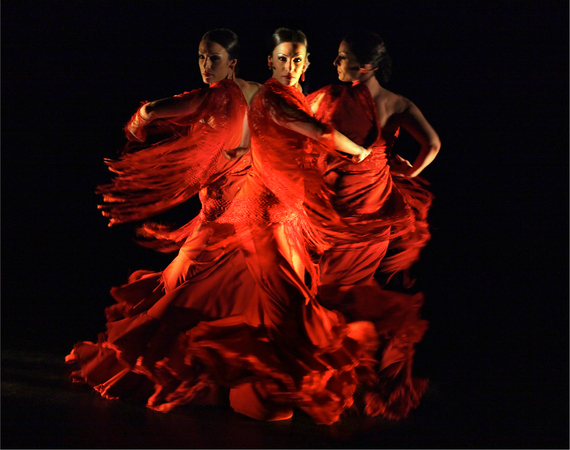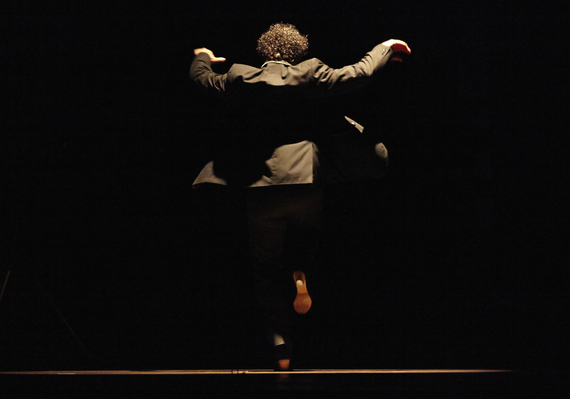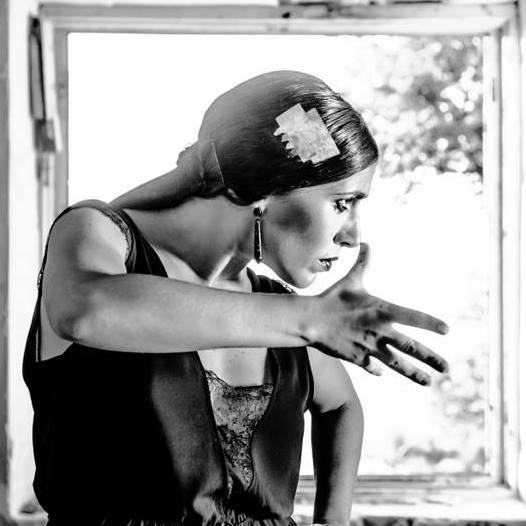Photo credit: Angelica Escoto Photography
16 flamenco artists sit in a restaurant, famished after a night of performance. They smile and laugh, gulping down their meals. Suddenly, one of them stands to sing. Unsurprised, his tablemates join him, clapping to the rhythm and improvising lyrics for dinnertime ambiance.
The evening lends itself to a more intimate encore offstage. After all, flamenco isn't about an auditorium of spectators and pre-choreographed repertoire. At its core, the art form reflects on the kind of humanity and sentimentality showcased on a midnight in May at a forgotten dining room.
Flamenco Vivo's artistic director Carlota Santana revisited the scene, still in awe of a moment that captured the essence of her work. "It was like the soul of everybody coming out, but it was joyful," she explained, exhilarated.
Indeed, flamenco is all about soul, passion itching for release. It comes from Andalucía, Spain's simmering southern region that inspired Federico García Lorca to write prose like "to burn with desire and keep quiet about it is the greatest punishment we can bring on ourselves." In its borders lie gypsy collectives and Arabic architecture, the archives of Ferdinand Columbus and the Alhambra. As Santana put it, "Spain has always been a land of immigrants," and Andalucía, with Islamic rule during the Middle Ages and continued Romani influence, is perhaps one of the most vivid examples of cultural exchange in Europe.
And so flamenco itself must embody its home's fervor, evoking mystery and sensuality amidst menace and grit.
"Flamenco is a mix of many, many cultures," Santana said. "I think the important thing that reaches people no matter what culture they're from is the emotionality of the art form. All our emotions are very universal. Everybody, no matter who you are or where you're from, is happy, sad, angry, depressed... The whole range of human emotions is expressed through the flamenco art form."
Of course, the dance also harbors the appeal of "the other" thanks to its gypsy association, which has boosted its popularity abroad. While Santana emphasized that flamenco is not solely a product of Romani customs, she did admit that it has probably benefitted from the magnetism of exoticism.
"People were attracted to it because of this gypsy lure of something different and something a little bit frightening and dangerous," Santana continued. "Anybody who's different or seems to be of the other side is very attractive to people who are on this side."
However, as artistic director of Flamenco Vivo, founded in 1983, Santana aims to push beyond this fascination with difference to share the true beauty of flamenco with the American public. She cherishes the art form as a personal gift that has filled her life with happiness, and she wants to make it more acceptable and accessible in the United States. She's trying to get people to "understand what we do and who we are" one demonstration at a time, and over the past 30 years, she's made significant headway. In fact, this week, her troupe is the first to perform flamenco at the BAM Fisher in Brooklyn, reaching new audiences at Ashland Place.
Photo credit: Angelica Escoto Photography
On the bill are three world premieres by esteemed choreographers in the field. Ángel Muñoz has produced a 50-minute piece with four dancers (including himself) and six musicians. Titled Angeles, the work looks at Muñoz's nuanced character -- his machismo, his sexual femininity, and his fears of the future.
For its second debut, Flamenco Vivo plucked Enrique Vicent and Antonio López from Madrid's El Certamen de Coreografía de Danza Española y Flamenco competition to set their Martinete-Seguiriya on the company. Guadalupe Torres will also present her new solo, Ausencia. As Arlene Croce wrote in 1986, "The primary emotions of flamenco make it a soloist's art," and after winning Madrid's Certamen twice, Torres is more than qualified to capture Croce's ideal of the flamenco dancer who "is provoked to confession by the music."
Photo credit: Marcos G. Punto
While the BAM stint sounds tremendous, it's no more grandiose than that evening at a restaurant, singing and clapping in unison. Art is so often a lonely profession, unique for its sacrifice and suffering. But at least among Flamenco Vivo, there's camaraderie in the artists' love for what they do, and that makes long hours of rehearsals and road trips worthwhile.
"There's something very special about what travels in the flamenco world," Santana claimed. "It really brings artists together."


